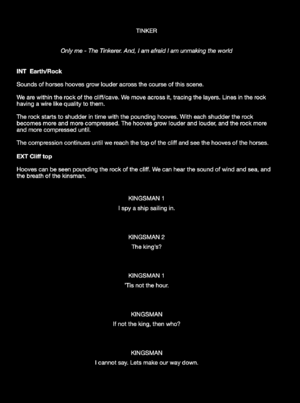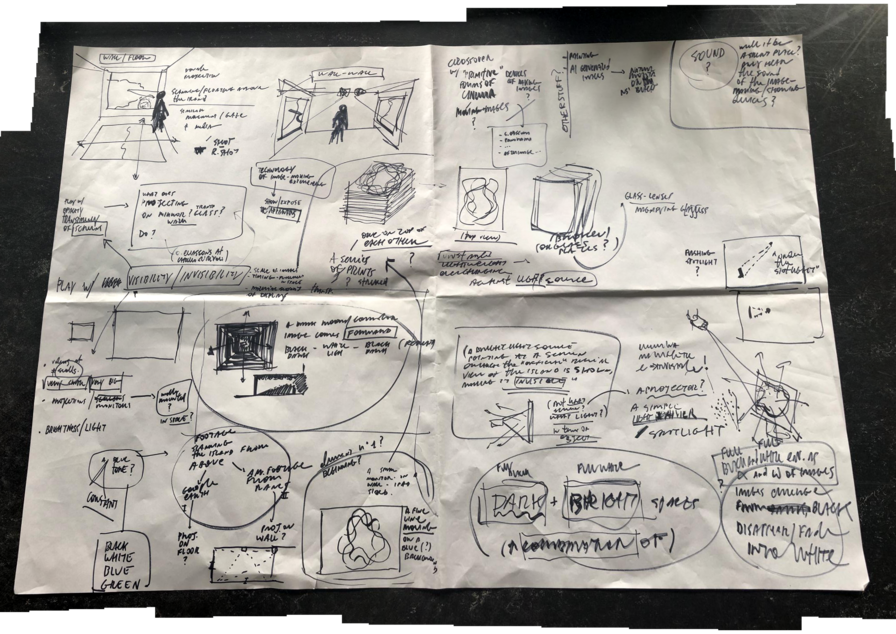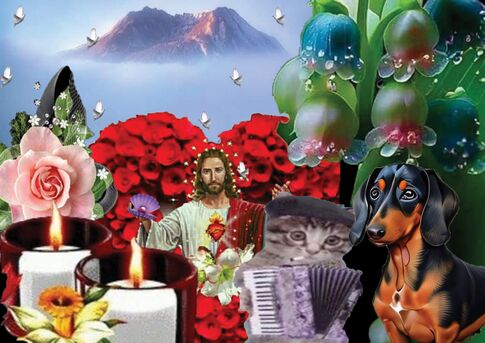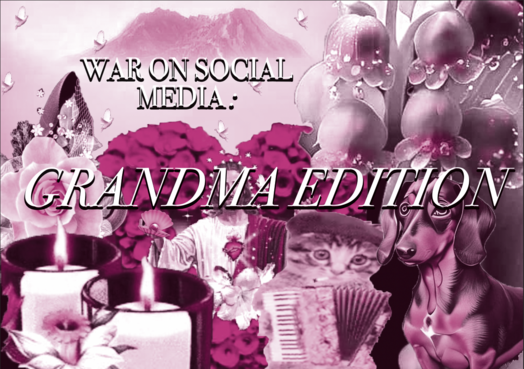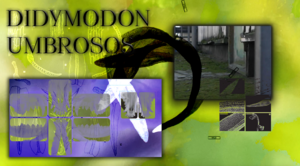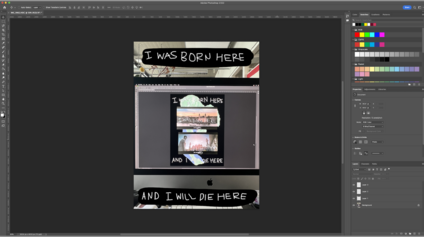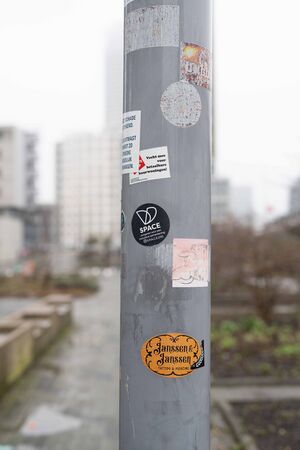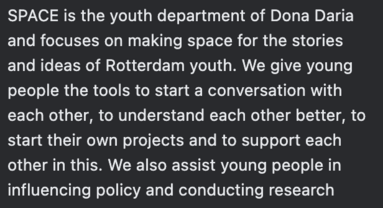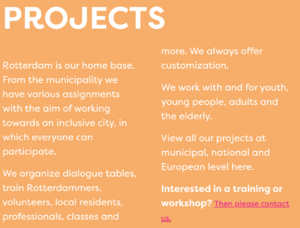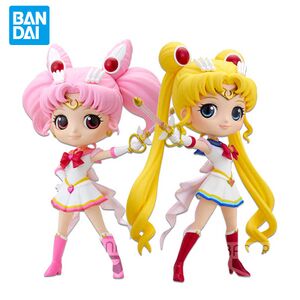PROJECT THAT MAY OR MAY NOT GET MADE
Todays URLs:
Pad: https://pad.xpub.nl/p/Future_projects_that_MAY_or_MAY_NOT_be_made
Scratch Directory: https://pzwiki.wdka.nl/mediadesign/ScratchDirectory
Home: https://pzwiki.wdka.nl/mediadesign/Future_project_that_MAY_or_MAY_NOT_be_made
Add your outline and images here:
Arabella
Will You Meet Me Here (Part II)
Using prose, music, actors, 3D modelling, video and digital interaction software, Will You Meet Me Here (Part II) invites audiences to enter a cave wherein lies the forgotten futures and histories of technology; and the people who have always and continue to resist - insisting on keep the door of imagination open. I aim for this work to be 10-15 minutes in duration.
Why make it?
I want this work to carve out a space to resist and reveal the power dynamics that are shaping our imagination around technology. As an artist, I think we can use our sensitivities to be aware of when an imaginary around any subject matter is being hijacked. Currently, this subject matter is my primary concern due to the discrepancy between the potential these technologies have to effect the lives of everyone and the small group of people who yield the power.
Workflow
I would like to split the project into _ stages: research/sketching, writing, shooting, editing and detailing. The research stage consist of two sections: reading/watching/listening and sketching (i.e. developing the content and aesthetic of the work). Following this is a writing stage, which is where I will decide on the script. Then shooting/creating, this will consist of live action, digital animating and potentially coding. Lastly, the editing period - which will also be the point where I invite feedback and focus on details. Make a timetable for the project
Timetable
START: Now
24th May - June 4th: Research
June 5th - June 23rd: Script Writing
June 23rd - August 1st: Shooting
August 1st - September 11th: Editing/Detailing/Feedback
END: 11th September
Add images (today's scratches here)
SCRATCH 1
SCARTCH 2: Draft some audio for the opening scene File:Scratch Audio.mp4
SCRATCH 3: using blender create a rock material and engrave it with some text from the scene above.
Yalou
Eva (Video Documentary, duration 10 to 15 minutes) will be about the connections to my grandmother,Eva; her music (she was a piano teacher and wrote her own music), and the Hungarian culture (she fled to The Netherlands in 1956 because of the Hungarian Revolution). The piece will chart the different connections that my mother, brother, uncle and me have with the meaning of Eva. And how we feel that this connection and the being of my grandmother still has influence on our lives now.
Why make it?
I feel that this is an opportunity for me to connect with my roots and ancestor(s). It is a connection that has always been there but has never been explored. I am curious to what the dive into this personal connection will develop for me and others.
Workflow
Stage 1: At first I have to go through all the family archival footage, my grandmother's written letters and her written music.
Stage 2: This upcoming summer I will be visiting Budapest and film what once was my grandmother’s home, school and living environment.
Stage 3: And than the most important voice is her music and how we connect to that, my brother is diving into that with me.
Stage 4: This whole process will be recorded, just like all the conversations that I will have throughout it.
Timetable
June: Go through the archival footage, Making music with brother and start conversations
July: Visit Budapest, Start selecting archival footage, Making music with brother and have conversations
August: Making music with brother, have conversations, start editing FINISH: Visiting Budapest
September: Making music with brother, Have conversations, Editing, Start structure first edit FINISH: Go through the archival footage.
Oktober: Making music with brother, Have conversations, Editing
November: Finishing up the music, Have conversations.
December: Have conversations
FINISH: Finish music, Finish first edit …. … … … May: Final edit of the documentary.
ScratchDictionary
1.Find archival footage that fit the connection to a someone (my grandmother Eva)
2. Use piano recording to write a poem about connecting
3. Edit the found archivel with existing archival and the music
1.https://youtu.be/Kh5wO7r0uxI
2. Poem is in Dutch:
Het is allemaal bedacht, fladders in mijn hoofd.
Jouw realiteit is te zien, in alles wat is bewaard.
Maar nu spreek ik voor jou, want jouw zijn is zo aanwezig.
liefde
angst
Voel
hoor
De noten die spreken.
Genoeg om te maken.
Dit is geen verering
Dit is het zijn, het zijn van ons.
De keuzes die zijn gemaakt
Want we zijn verbonden.
Allemaal verbonden.
En we zijn benieuwd
Naar de wereld die onze banden heeft gelegd.
En we zijn benieuwd
Naar het effect van de wereld op onze banden.
Dit is het zijn.
De maak van wat voelt.
De maak van het nu.
Dat verbonden is met toen.
Maar misschien allemaal bedacht als fladders in mijn hoofd.
3. https://youtu.be/berqeeIXunM
Add images (today's scratches here)
Claudio
Images from a desert island (VERY BAD TITLE, i'll think of something better)
What?
A multimedia installation in an exhibition space about North Sentinel Island. [Steve: what will we see? (describe some of the images)] It will be made of a series of excerpts - mostly short moving images pieces, but not exclusively - that were produced in the research process. It will be displayed as a fragmented yet cohesive body of work, in different media - projections, monitors, prints, … - that tries to give a sense of what the project is about and what are the tools that I have been using in it. [what kind of role are you taking on as an artist in this exhibition? are you presenting it as documentary / speculative work ? What will the narrative?] [will you use excerpts of your EYE film? ] >> will be a critique on the violence and the power dynamics that envolved in making images on this place.
Why make it?
I want to make it as an intermediate stage between the early phase of the research that I have been carrying so far and its final outcome, that I still imagine as a one-screen film piece. I feel the need to bring together in a temporarily stable form all the different bits and pieces that this research project has been unfolding, to make sense of their mutual connections and to get a more clear idea of the direction that the project will follow. Ultimately, I would like to have a chance to experiment with possible ways of bringing my research and thoughts outside of my computer/studio/head, showing it in a space and seeing the way it can affect an audience. I think it is a wonderful idea to place the research and all of your work outside of the studio / your head. Do you have any examples of exhibitions / art works / installations that you might drawn inspiration from to build your installation?
Workflow:
Make a selection of the most important elements/excerpts of the research that I feel I want to share with the audience. Make sense of their mutual relation and devise ways to make them visible/understandable/appealing to an audience. Find a space and spend time experimenting ways to bring these elements in it - think of spatial relations, dimensions, time/space experience. Open it to the public, get feedback, learn something from it, carry on the project towards its next steps. [ what are strategies that you can implement to make the research visible / understandable / appealing to an audience ?]
Timetable:
Select fragments/parts of research that I want to display in the installation. Make maquettes, draw plans, write notes about the form that the installation could take, about the way these elements could possibly inhabit and make sense together in an exhibition space. Try to find a suitable space. And find a good compromise between my plans to its physical constraints. Find someone who can deal with the practicalities of organizing an exhibition. Make the exhibition. [ what type of space do you envison the work to be exhibited? ]
SCRATCH - gather ideas about the elements of this installation; imagine their forms, their devices, their possible ways of being in a physical space; take notes, draw sketches to keep track what you come up with.
Luni
War On Social Media - Grandma Edition is a lightweight, colourful, quirky (short) experimental documentary about old/er adults on social media, focusing on feelings and interactions. I got inspired to make this project by observing my grandma’s (71) behaviour on social media (Facebook) as she’s a huge stalker of her ex husbands and get’s mad if someone from the family likes a picture that he posted, and turns it into this silent war on likes, posts emotional images and is pretty addicted by now (also joined a club where they teach elderly to use smart phones (better)). My other grandma (79) have never been on the internet, still has the button phone, yet claims she would like to write some comments on daily news posts, and I’m sure she would be a huge internet troll.[:-) love the humour here:-)
Why make it?
I think a lot has been already told and explored about the general effects of social media, but I would like to focus on the side of the people who have suddenly entered this new online world of relationships after spending the majority of life offline.
Workflow
1. Observing grandma’s post’s on facebook, talking to her about what’s going through in her head; collecting screenshots and maybe some related found footage.
2. Stalking fb group ‘Vienišų Senjorų Grupė ‘(Single Senior‘s Group).
3. Talking to my internet free grandma, scrolling through facebook feed together, asking her to write her comments on the sheet of paper.
4. (In the ideal situation) Organizing a workshop for the seniors to create hearthwarming videos (as they do with images (see example))
Timetable
No timetable. Do this project on the side of my ‘serious project’, on my free time, not pushing it, collecting material when feeling like it.[<< S:please imagine it is a real project with a deadline]
Scratch:
- collect 10 images from Lonely (or single?) Seniors fb group. Look for the images that are different from each other, different elements (as they tend to be very similar).
- make a collage of those images (moodboard for the upcoming film?)
- design a poster
Add images (today's scratches here)
Sam
What?
The project is about sitting spaces that emulate and reflect upon public space; ideally in an exhibition format that makes use of sound, image and physical material. Short videos, (fragmented) conversations, collages of photo and constructed
Why make it?
I want to make it because I am continually working with encounters, with so-called ‘strangers’ that I meet in my life. I am very curious how other people have encounters with each other, but also how people encounter the physically built (or non) spaces within urban environments. What are the theoretical intentions of these places, and how does this come out in practice?
Workflow
To make this, I need to begin by selecting different places that I would like to specifically focus on. Then I must spend lots of times in these places, observing and melting into them, but also actively speaking with people there (and away from there), recording audio and visual (separate and together). I then need to proceed with sifting and sorting through the collection of material I gather, to try to build a larger cohesive work amongst it all. Finally I would like to build a public space, that can be used to ones liking, while exploring the sounds and images.
Timetable
June: research, look at different places. Also begin experimenting/research through recording people discussing the topic (Room for Sound)
July/August: Spend time in these places, each day spend bringing a different tool or combination of tools. Review materials, attempt to understand and strategize a strong audio-visual language for the project
September: Spend more time, focus on collecting quality material by honing in on my method/process
October, November, December: Organize material, construct working/rough versions. Begin to plan construction of the space.
December onward: revise, revise, find a space (and money!) to put it all together.
Add images (today's scratches here)
Anni
What? [S: Please give provisional title to the project]
I am making an art installation about the growth of mosses that are [re] covering areas of trauma in Zuid-Kennemerland. The installation is presenting a space where green mosses are covering up the scars and wounds of industrial territory and war. The work provokes critical thinking about the agency of more-than-human forces that are reclaiming, recovering, recolonising the natural landscape. [what kind of media/materials are you planning to use? how do you plan to visualize these topics/situation? what context - a gallery, a museum, an open space... - would be the most suitable for this work?]
Why make it?
As an artist, I constantly question my position, not only as a creative but also as a human being that has agency over the world she lives in. With this work I am inviting humans to question the hierarchy between human and more-than-human entities. I am determined to make this work because I want to raise awareness about the polluting factory that is destroying the natural landscape of my hometown. [ I find very interesting the overlapping between these big/universal topics and the fact that you are working on a place that you have a deep personal connection with - I think that this could possibly be a strong point to keep in mind in developing this project to make it unique and possibly more touching for others as well ]
Workflow
Stage 1: Research and document the Bunker Route od the WOII in Zuid-Kennemerland.
stage 2: Research the growth of The Schaduwtandmoss that is growing on the industrial terrain of the Tata Steel factory next to Zuid-Kennermerland.
[how do you plan to carry this research part? do you have to ask for permission to access this place/ to take pictures/recordings ... I think it's always best to sort these practical things out beforehand]
Stage 3: Research the biological functions, DNA and capabilities of the mosses growing in these spaces. > Work together with a biologist who is specialised in researching mosses. [S: how so? Who do you contact? What kind of dialogue do you want to establish?]
Stage 3: Translate the documentations into visual data analyzations. [ collage, video, photography, graphic design, 3D renders ]
stage 4: Translate the data analyzation into data dramatization. [ think about the display of these data visualisations > Scenography > Music > Environment [are you already familiar with these kind of softwares/practices of data visualization? if not, maybe find someone in the school who can help you with it?]
Add images (today's scratches here)
Aitana
What?
A film approaching orthopaedic environments, exploring physical and mental spaces. Physical spaces being the workshops where the prosthesis and orthosis are made and commercialized, whereas mental spaces will be explored by encounters and conversations with patients. My aim is that the exploration of these two worlds will take a hybrid form between documentary and fiction involving a Voice Over narration.
Why make it?
I have been a patient since I was a child and I have also had the (unexpected) opportunity to work in a multinational orthopaedic company. This made me discover the massive male burden inherent in the whole process of patient treatment and the alienation that accompanies the production of medical products in the capitalist system. I am interested in creating spaces of encounter with workers and patients to talk about the process of both physical and mental treatment.
Workflow
The working process will be divided into three main stages (which I call "active or external") and a parallel one that will accompany the whole process (which I call, for the moment, "internal"). The first is a pre-production stage, resulting in a list of orthopaedic centres, organisations or institutions that I can contact either to meet with them or to obtain archival material. After this, the production will consist on the creation of sound, texts and visual material resulting from the potential encounters and exchanges. The editing will take place in the last stage, the post-production. These three active stages will be accompanied by a parallel process of readings, theoretical research and reflection and also by the creation of other type of content subjected to the world of the imagination.
Timetable
Preproduction: June - July 2023
Production: September 2023 - February/march 2024
Postproduction: march - may 2024
Add images (today's scratches here)
#SCRATCH 1: create a short story with words related to the term "orthopedic" Our character was born somewhere in Europe in the 20th century. English was the omnipresent language tracing and mapping the historical context in which he was born, raised and dead, but we don’t think he spoke English, he could have spoken a more eastern language, perhaps. His family was middle class pero se construyó a sí mismo, humildemente, pero no era un pedante, era un buen tipo, amable, trabajador. He was successful all his life, he helped poor people, in general. Nevertherless, despite he always had a positive mood, he also had lots of destructive thoughts related to his profession, surgery. He was a surgeon. He could have been a physician but may be this would have been too much. He dreamt about repairing and sewing but also about breaking and exploding things, in general, in a very violent way. These thoughts, at some point, became quite problematic, he didn’t know what to do about it, he had lots of nightmares, he was very tired. He thought he could improve his sleep by taking some kind of mental protection in order to understand more his subconscious mind, so he thought that speaking with a friend would be great. His friend, an orthodontist suggested him to improve his posture while sleeping. Also a new pair of shoes could help. “It is paradoxical” he thought.
#SCRATCH 2: create a short dialogue based on internet research From the 1880 til 1907 various pests cost major damage to local crops. By the turn of the century, pests like the coddling moth infected apples grown in the Pájaro Valley. Growers lost nearly half a million dollars during that time, which is equivalent to over 13 million dollars in today’s money. Two brothers who where living in that time were a key part solving this problem. CLASSIC V2: ray ortho sensor, sharp wall bug. NEW V3: collision ortho sensor, sharp wall ok :) Perfect collision CLASSIC V2: Telepatic fly bug. NEW V3: Perfect collision CLASSIC V2: sewer, tubes, collision, bug NEW V3: perfect collision behind objects, perfect collision behind tubes. After experimenting, they were able to formulate a pesticide that was effective in stopping pests but wouldn’t damage the crops like previous pesticides. The two brothers found a company in Watsonville called ORTHO and sell the product worldwide.
Te
What?
A time-based media titled Repeat After Me will focus on the repetition of dialogues and actions in Thai propaganda films that were used to brainstorm and manipulate people in the society. It will create the sense of hypnosis and make you aware of what you are perceiving. It will be shot on both digital and analog format.
Why make it?
I would like to develop the research on propaganda in Thailand further. I consider "The Holy Sponge" , my recent film, as a start of creating political work in an ironic approach. I think there is a lot of possibility to dive deeper into this topic and it is one way to understand the society that I grew up in.
Workflow
Firstly, I will select and watch the propaganda films that are effective in terms of implanting a certain idea, analyse them and pick some terms or sentence that were used several times in the films. Secondly, I will create work based on the selected term and sentence that I got from the previous stage. Then I will explore the term, phrase or sentence from the works I made. Lastly, I will select some terms and sentence to depict them through time based media.
Timetable
Now - June : Research on propaganda films from Thailand. Watch and select the films regarding their efficiency in brainwashing. July - August : Analyse films and make work based on selected terms or sentences that derived from the films. September : Analyse the works I made from previous stage and explore some terms, sentences, ideas.
October : Select the final terms, sentences and direction of video. Plan on pre-production process.
October - November : Production, shooting.
December - January : Post- Production, Editing, Color-Grading.
February : Feedback and Fixing.
Add images (today's scratches here)
- Find a propaganda film you found on https://archive.org/ or other source on internet
- Collect the cheesy terms / dialogue said in the films
- Reproduce it (again & again)
Sara
What will it be?
I would like to create a short documentary on the Rotterdam city's secret identity through the stickers all over the city. I want to explore and follow the person or people behind them and interview them or make footages of their daily life.
Workflow
The first stage is to go for a walk in the city and find the stickers are interesting to me. step two is to make pictures of the stickers for future refrencces and organize them. step three would be to google the stickers or scan their QR code or search the name on them to see where it would take me. step four is to contact te person or go whereever they are and start a conversation with them and ask if they are ok to be filmed. step five is to take picture and footages of the person and their story of what made them to make that story and explore the secret identity of the city.
Timetable
Now-june : start the step three because i already made the step one. july : start the step four and shooting and start the editing process alongside of shooting. work on the script of the film and sound too. september : hopefully i have the irst draft of the film. october - november : work on developing the film to the final draft december : search for galleries to have an exhibition of the picture and a short version of the film january : make a site for the project to find more artist and collect more stickers february : enter the festivals with them film i made and have the exhibition in more galleries and cities
Add images (today's scratches here)
1) take pictures of the stickers through the city
2) research one of the stickers
what is Dona Daria?
3) try to explain the history behind the sticker in a paragraph
Dona Daria is an organization based in Rotterdam that helps the society to grow and makes the opportunities for them.
the name Dona Daria means sharing knowledge and learning. The space, is a department in Dona Daria which works with the youth generation and helps them to grow. they recently started a podcast with Matheus Santana, a content creator who recently moved to the Netherlands. the recorded the first episode recently and i think i am going to contact them about the space and the podcast to have an interview with the Matheus.
Dona Daria has fifteen different programs right now that are active. i personally think connecting with this organization would help a lot of expats and students who recently moved to the netherlands and try to be a part of the society.
Muyang
What?
I want to make a series of collage sculptures/paintings from leftover recycled plastic to establish my queer kinship with plastic. I wanted to see this project as a game in everyday life, exploring the potential of plastic through aesthetic experiments in blending color, transparency, opacity, texture, volume, etc. I want to use a playful approach, inherited from the Dadaist subversion that appeals to me, which is closely linked to collage.
Why make it?
I spent my childhood in the rapidly developing years of China, growing up with lots of plastic toys and colourful stickers. I had a wall of stickers in my house that was covered in all sorts of colourful, glowing plastic stickers and had lots of traces of my handiwork. Playing with plastic is still very popular in China and many adults still enjoy it. Many children buy cheap, colourful plastic, moldable materials from small shops in front of schools. I secretly played with tape, ballpoint pens, coloured ink and other materials in class, it was sticky and malleable and I enjoyed the richness of the transformation process inside.
Workflow
I am reading some articles on material kinship, non-binary materiality, and forms. I think I will start collecting materials in the near future (downloading from the internet and printing them out at print stations, collecting from everyday life, buying from second-hand shops etc.). I will then start working on a physical sculpture and photograph some of the results of the process through photography and then print them out again as material.
Timetable
June: gathering materials and reading literature
July to August: Complete initial production
September to October: get feedback from tutor and complete
Find a plastic toy from your childhood that relates to my gay identity
Think about this image
Obviously the characters in this image don't have much to do with the real Japan. In my time dating gays all over the world, I found out that everyone grew up under the influence of Japanese anime. It's a kind of fabricated pseudo-Japan. White gays like to appropriate East Asian aesthetics in their rooms, in the places where they fuck and party. Violence happened when I embraced a globalised homogenised queer identity. I want to find another way to use this material and to avoid this orientalism and ornamentalism.
The image shows an elaborate Japanese-made toy. But I didn't have such elaborate toys as a child, most of them were cheaper Chinese products. It got me thinking about this culture of copying things that are well-known or authoritative, not just criticizing with clichés the lack of attention to copyright, etc.

